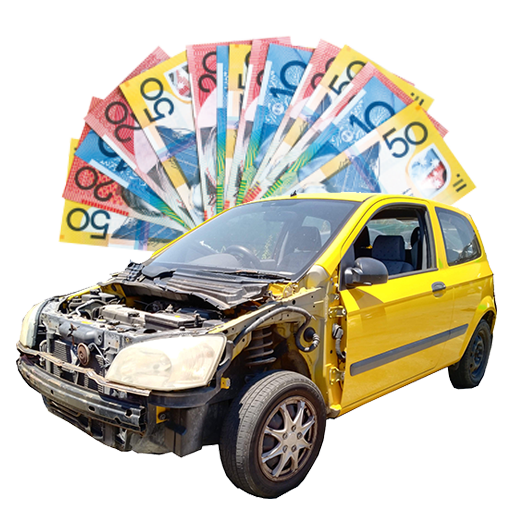Right, so you're thinking of scrapping your car. It’s not just about hauling away a hunk of metal; it’s about cashing in on its hidden treasures. And often, the biggest prize is the catalytic converter.
Here in Australia, you could be looking at anywhere from $250 to over $1,000 AUD for a single scrap catalytic converter. That massive price gap all comes down to what’s lurking inside.
What Are Catalytic Converters Really Worth?
It helps to think of your car's catalytic converter less like a spare part and more like a miniature, high-tech mine on wheels. Sure, its day job is to clean up your car's exhaust fumes, but its scrap value comes from the tiny specks of precious metals—platinum, palladium, and rhodium—that act as the catalysts. These metals are incredibly rare and expensive, which is why your old converter is such a hot item.
The cash you get isn't just a number plucked from thin air. It’s directly tied to a few key factors that dictate its real worth. Getting a handle on these is your first step to making sure you get a fair deal.
The Big Things That Decide Your Converter's Price
A few main elements come together to determine the final scrap price. The biggest one by far is the live global market for those precious metals. Just like gold, their prices bounce around daily based on global supply and demand, which directly affects your payout. When rhodium prices spiked recently, for example, the value of certain converters shot through the roof.
Another huge piece of the puzzle is the specific car the converter came from. Converters aren't all made equal, and the amount of precious metal inside can vary dramatically.
- Original (OEM) vs. Aftermarket: Converters fitted at the factory (OEM) are packed with a much higher load of precious metals than the cheaper aftermarket ones you might get from a local mechanic. Because of this, genuine OEM parts always bring in more cash.
- Car Type and Make: High-performance cars, diesel utes, and European luxury vehicles tend to have more powerful converters loaded with more metals to meet stricter emissions standards.
- Hybrid Powerhouses: Hybrids like the Toyota Prius are legendary in the scrap world. Their converters are known for having a higher concentration of rhodium, putting them right at the top of the value chain.
A study of the Australian market found that scrap values for converters can change weekly, reflecting the volatile nature of precious metal spot prices. This makes it crucial for sellers to seek up-to-date quotes from reputable dealers. You can explore more insights on Australian converter prices from industry experts.
When it comes down to it, the precise model, its condition, and whether it’s an original part will seal its final value. Knowing exactly what you have is your best weapon when it’s time to sell.
To give you a clearer picture, here’s a quick breakdown of what to look for.
Quick Guide to Converter Value Factors
| Influencing Factor | Impact on Price | Example |
|---|---|---|
| Precious Metal Markets | High | A global surge in palladium prices will directly increase the scrap value of palladium-rich converters. |
| OEM vs. Aftermarket | High | An original Toyota converter will be worth significantly more than a generic aftermarket part for the same car. |
| Vehicle Type | Medium to High | A converter from a BMW X5 or a diesel Ford Ranger typically has more metals than one from a small petrol hatchback. |
| Hybrid Vehicles | High | Converters from a Toyota Prius are exceptionally valuable due to their higher-than-average rhodium content. |
| Physical Condition | Medium | A converter with its internal "honeycomb" intact is worth more than a damaged or empty one. |
As you can see, it’s not just one thing but a combination of factors that sets the final price.
What Makes a Catalytic Converter So Valuable?
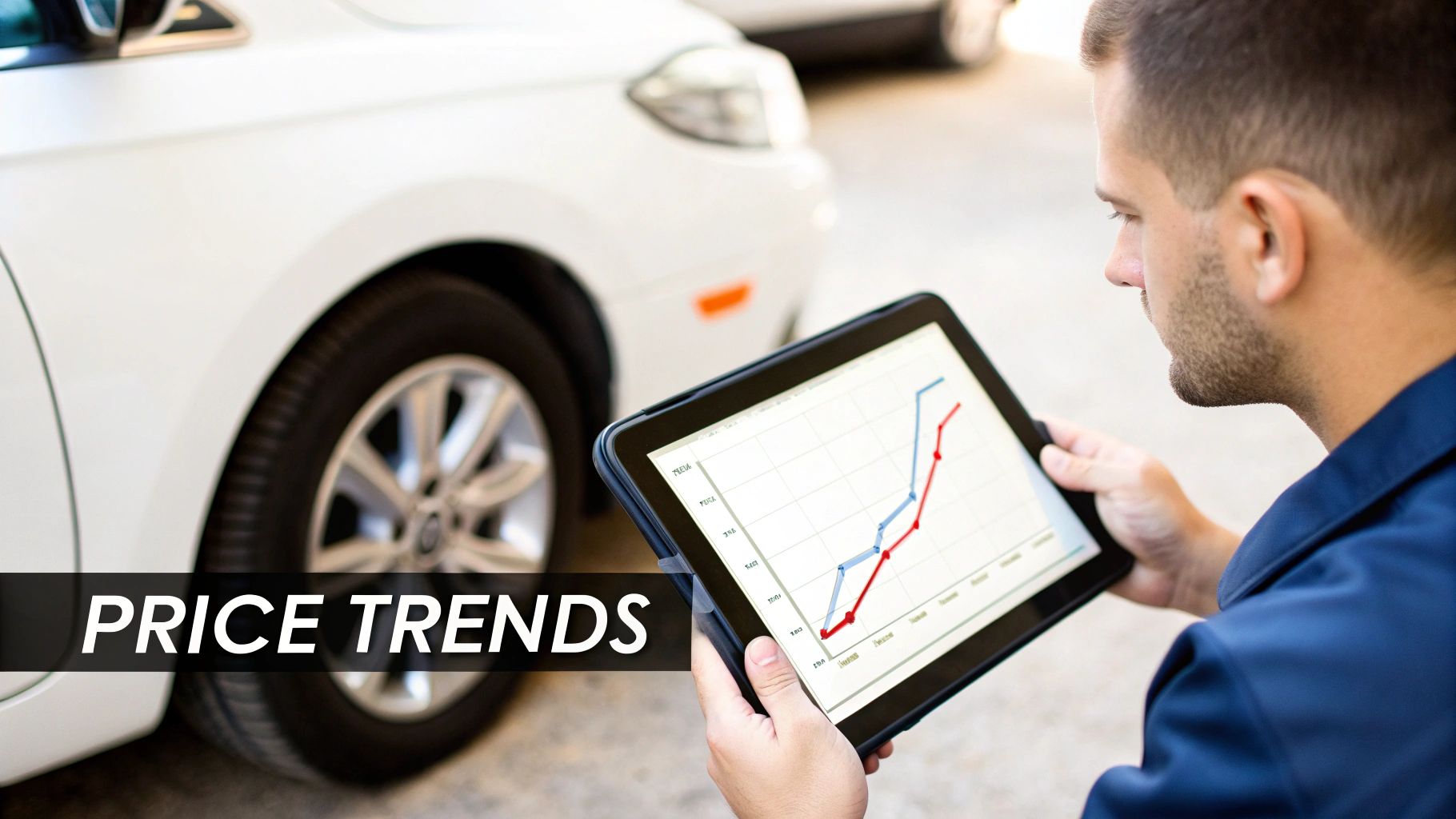
It’s easy to look at a catalytic converter and just see a bulky piece of your car’s exhaust system. But its true value isn't in the steel casing; it's hidden inside. Think of it less like typical car scrap and more like a small, well-protected vault filled with a cocktail of rare and incredibly expensive precious metals.
These elements are coated in microscopic layers over a ceramic honeycomb structure, and they're the workhorses that perform the converter's pollution-busting magic.
At the heart of every catalytic converter are three members of the Platinum Group Metals (PGMs), each with a specific job:
- Platinum (Pt): This is a powerful catalyst, brilliant at turning toxic carbon monoxide (CO) and unburnt fuel into less harmful substances.
- Palladium (Pd): Often working alongside platinum, palladium is also fantastic at tackling CO and hydrocarbons, especially in petrol engines.
- Rhodium (Rh): This is the real superstar. Rhodium is exceptionally good at reducing nasty nitrogen oxides (NOx) back into harmless nitrogen gas.
These aren't just industrial materials; their prices fluctuate wildly, much like stocks on the share market. Global demand from car manufacturers, electronics companies, and even the jewellery industry sets their day-to-day value. This is, without a doubt, the single biggest factor determining what your old catalytic converter is worth.
How Global Markets Affect Your Payout
When a scrap buyer gives you a price, they're not just plucking a number out of the air. Their offer is calculated based on the live market value of the platinum, palladium, and rhodium they can recover from your specific converter. So, if new emissions laws in Europe cause a spike in demand for rhodium, the value of converters rich in rhodium right here in Australia will climb too.
A scrap converter's price is a direct reflection of its precious metal load. It is a constantly shifting target, tied to global commodity markets that can change daily. This direct link is why a quote is often only valid for a short period.
Of course, the "big three" PGMs are the main event, but other metals in a vehicle add to its total scrap value. Copper, aluminium, and brass might not be as glamorous, but they certainly count. Recent Australian market data shows copper scrap can fetch between $5.00 to $10.00 per kilogram, proving that lots of different car parts have real value.
When it comes to converters, though, the tiny amounts of precious metals inside completely overshadow everything else. This reliance on market prices is why getting familiar with the factors influencing overall scrap metal car prices can really pay off. The more you understand what drives the value, the better position you're in to get a fair price for every part of your end-of-life vehicle.
Why Not All Converters Are Created Equal
It’s a common mistake to assume all catalytic converters are basically the same. In the scrap metal world, nothing could be further from the truth. The reality is that catalytic converter scrap prices can swing wildly, with some fetching hundreds of dollars more than others that look almost identical.
So, what gives? It all comes down to the converter's original job.
Think about it like this: a high-performance ute needs a more powerful engine and braking system than a small hatchback. The same principle applies to their emission control systems. A big, powerful engine pumps out more pollutants, so its catalytic converter needs a much heavier dose of precious metals—platinum, palladium, and rhodium—to neutralise those extra fumes.
This is exactly why a converter pulled from a big diesel truck or a European luxury sedan will almost always be worth more than one from a standard family car.
OEM vs. Aftermarket: The Great Divide
The single biggest factor determining your converter's value is where it came from. Is it an Original Equipment Manufacturer (OEM) part, or is it a cheaper aftermarket replacement? This is the first question any reputable buyer will ask.
OEM converters are the ones installed on the vehicle assembly line by the carmaker. They're built to high standards to meet strict, long-term emissions regulations, which means they are loaded with a generous amount of those valuable precious metals. They’re designed to last the life of the car.
Aftermarket converters, on the other hand, are all about being an affordable fix. To keep the price tag low, manufacturers use the bare minimum amount of precious metals needed to scrape through an emissions test. As a result, their scrap value is dramatically lower—sometimes they're not even worth the trouble of selling.
Here's a quick breakdown of the key differences:
OEM vs Aftermarket Catalytic Converters
| Feature | OEM Converter | Aftermarket Converter |
|---|---|---|
| Precious Metal Content | High | Low/Minimal |
| Build Quality & Durability | Built to last (10+ years) | Designed for short-term replacement |
| Scrap Value | High | Low to negligible |
| Identification | Stamped with manufacturer logo/serial numbers | Often generic, unmarked, or has a shiny shield |
Knowing whether your converter is OEM or a replacement is your first and most important step toward getting a fair price.
High-Value Vehicle Types
Over the years, certain types of vehicles have earned a reputation in the scrap industry for having particularly valuable converters.
- Hybrid Vehicles: The Toyota Prius is the classic example. Its engine runs differently from a standard petrol car, and its converter is famously packed with precious metals to handle that, often making it one of the most valuable on the market.
- Diesel Utes and Trucks: Big diesel engines create a lot of specific pollutants, so they need powerful converters with a hefty metal load to do the job.
- European & Performance Cars: Brands like BMW, Mercedes, and Audi have to meet tough European emissions laws, so they don’t skimp on the quality and metal content of their converters.
The image below gives you a good visual summary of how different factors—from the type of car to the age of the converter—all play a part in the final price you’ll be offered.
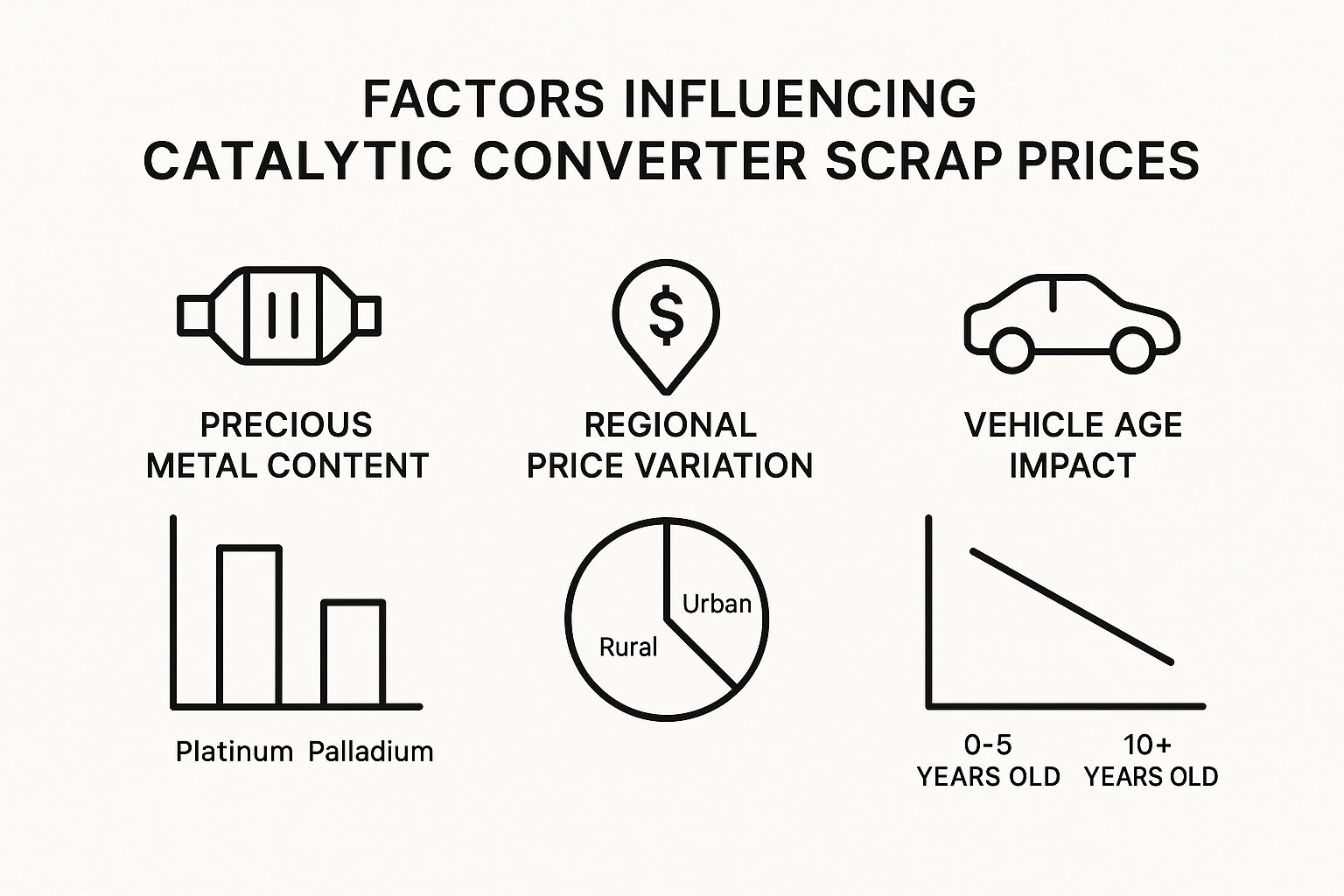
As you can see, the value is driven by much more than just the physical size of the unit. OEM parts from newer vehicles almost always have the highest potential value.
Ultimately, the Australian scrap market prices converters based on their specific serial numbers, which tell a buyer exactly what’s inside. These devices usually last for around 160,000 kilometres before they start to fail, meaning plenty of older cars on the road are sitting on a valuable recyclable part.
If you're getting rid of the whole vehicle, understanding the value of its parts is key to getting the best price. You might find the ultimate guide to scrapping a car in Australia helpful for maximising your total payout.
How to Identify Your Converter and Get a Quote
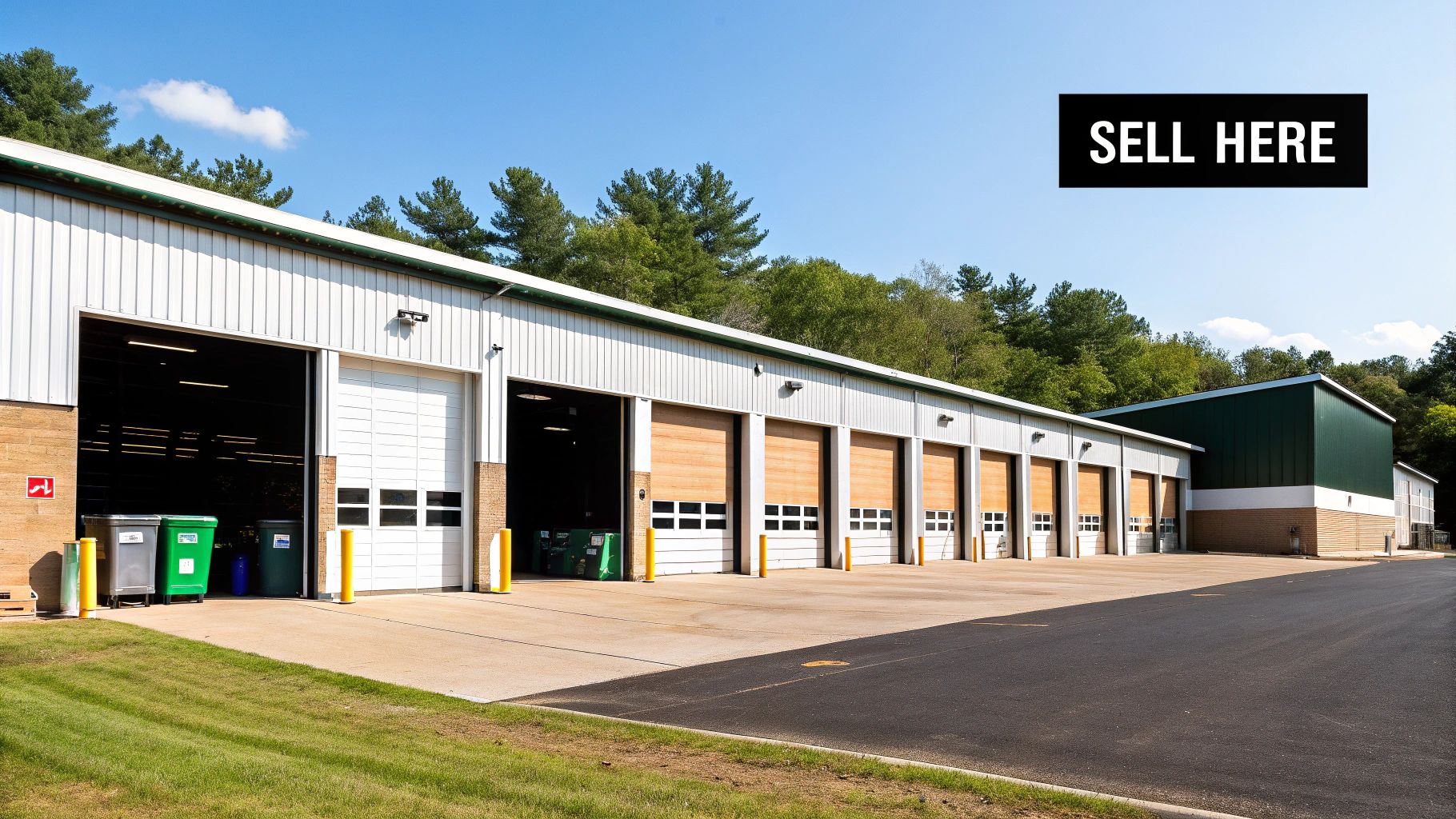
Getting a solid quote for your catalytic converter isn't guesswork; it’s about having the right details. Any reputable buyer will tell you they can't give you a fair price based on the car's model or the converter's size alone. They need specific codes to look up the unit and see what it's really worth.
Think of the serial numbers stamped on the converter's metal shell as its unique fingerprint. Those markings are the key a recycler uses to unlock its precise value. It's what turns a vague estimate into a firm, reliable offer on catalytic converter scrap prices.
Finding the Crucial Codes
First things first, you'll need to find and record the identification codes on the converter. This is a breeze if the converter is already off the car. If it's still attached, you'll probably need to get it on a hoist or have a mechanic help you get a clear look.
You’re searching for a series of letters and numbers, often right next to the manufacturer’s logo (like Toyota or Ford).
Don’t just rely on your car's VIN. While it’s useful information, the serial number on the converter itself is the real source of truth. It confirms whether you have a valuable original (OEM) part or a much less valuable aftermarket replacement.
Once you spot the codes, your next move is to document them properly. Good photos are your best friend when it comes to getting multiple, competitive quotes.
How to Prepare for a Quote
To make sure you get the best possible price and a straight-up assessment, a little prep work goes a long way. Following these simple steps will arm you with everything a buyer needs to give you a fair, data-backed offer.
- Take Clear Photos: Use your phone to snap a few well-lit pictures of the converter from different angles. Make sure you get one shot that shows the whole unit.
- Capture the Codes: This is the money shot. Get a close-up, in-focus picture of the serial numbers and any brand logos. If they're covered in grime, give them a quick wipe with a rag first.
- Note Your Vehicle Details: Jot down the make, model, and year of the car it came from (for example, 2012 Toyota Prius).
With clear photos and your vehicle's details ready to go, you're all set to talk to a buyer. You can easily text or email this information for a preliminary quote, which saves you a ton of time and lets you compare offers from the comfort of your home. A few minutes of preparation puts you in the driver’s seat.
Your Step-By-Step Guide to Selling a Scrap Converter
Alright, so you know what your catalytic converter might be worth. That's half the battle. Now, let's turn that knowledge into actual cash in your pocket.
Following a smart process is key to avoiding lowball offers and making sure you get a fair price. It's not just about finding the nearest scrap yard; it's about making a few buyers compete for your business.
Finding and Contacting Buyers
First things first, you need to find reputable dealers. Your aim here is to get several quotes to play off against each other, so don't ever jump at the first offer. You'll want to look for licensed scrap metal dealers, specialist auto wreckers, and dedicated catalytic converter recyclers in your area.
A quick online search for "scrap metal dealers" or "auto wreckers" near you is a good starting point. Any legitimate business will have a physical address and easy-to-find contact details. Make a shortlist of at least three to five potential buyers to create some healthy competition.
With your list ready, it's time to make contact. And because you've already got those photos and serial numbers handy from the previous step, you can get firm quotes without wasting a tank of fuel driving all over town.
- Email or Text Your Photos: Send those clear pictures of the converter and its codes to each buyer on your list.
- Include Vehicle Details: Don't forget to mention the car's make, model, and year to give them the full picture.
- Request a Firm Quote: Be direct. Ask for a specific price based on the information you've sent.
This method is incredibly efficient and lets you compare real, concrete offers side-by-side.
Understanding the Deal
Once the quotes start rolling in, it's time to weigh them up. Remember, the highest number isn't automatically the best deal. Hidden costs or tricky terms can easily sour a great-looking offer.
A fair offer is always a transparent one. The buyer should be able to tell you exactly how they came up with their price, tying it back to the converter's serial number and the current precious metal markets. Be very cautious of anyone offering a vague price without asking for specifics.
When you're comparing the offers, here's what to look for:
- Grading Process: How do they actually grade the converter? Is it based on the codes you provided, or do they use another system? You're looking for total transparency.
- Payment Terms: How do they pay? Is it cash on the spot, or will it be a bank transfer? Crucially, how long will it take for the money to hit your account?
- Hidden Fees: Always ask if the quoted price is the final amount you’ll receive. Are there sneaky deductions for processing, transport, or anything else?
Choosing the right buyer is about finding someone trustworthy who offers a straightforward transaction, not just the biggest number.
This same logic applies if you're getting rid of an entire vehicle. Finding a reliable service is everything. You can learn more about how to sell your car for cash in Adelaide to ensure the whole process is smooth from start to finish. By taking control of the sale, you put the power back in your hands and make sure you walk away with the most money possible.
Common Mistakes to Avoid for a Better Payout
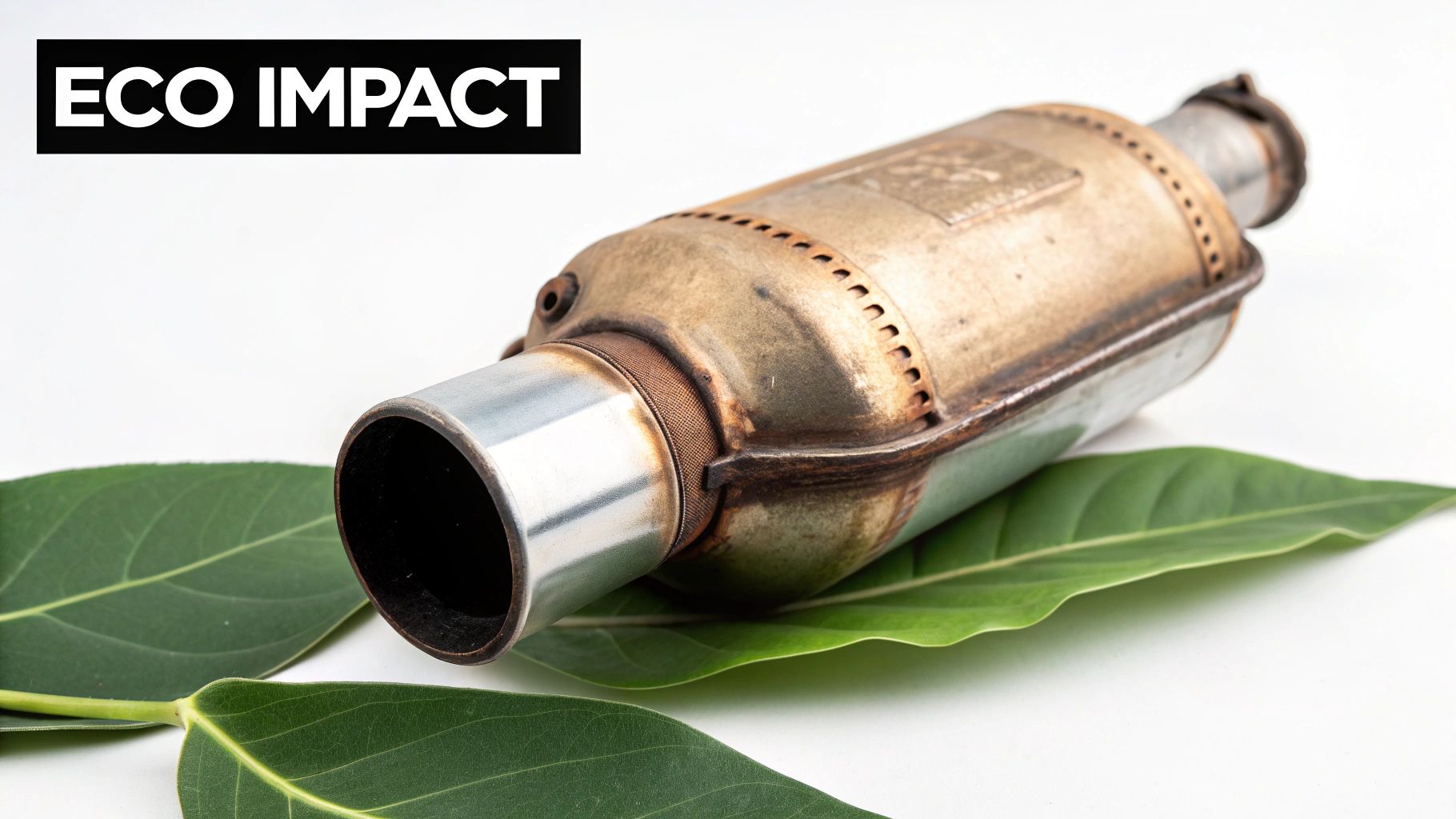
When you're trying to get the best catalytic converter scrap prices, knowing what not to do is just as critical as knowing the right steps. A few simple missteps can easily slice a big chunk off your final payout. Let’s walk through the common, costly errors I’ve seen people make over the years so you can avoid them.
The most common mistake by a long shot is simply accepting the first offer that comes your way. It’s a bit like selling a car or a house—you wouldn't just take the first person's offer without testing the market. The smart move is to get at least three different quotes to get a real sense of what your converter is worth.
Another major pitfall is trying to sell a converter without its identification codes. Honestly, it's like trying to sell a diamond without a grading certificate. It leaves the buyer to guess its value, and you can bet their guess will always be on the safe side—for them, not for you.
Dodging Deception and Myths
Who you sell to matters immensely. A sure-fire way to get a poor payout is to deal with the wrong people. Always make sure you're working with a licensed, reputable scrap metal dealer. The dodgy, unlicensed operators often don't have the proper gear for an accurate analysis and aren't held to any fair trading standards. That leaves you wide open to being lowballed.
It's also really important to bust a persistent myth: bigger doesn't automatically mean more valuable.
The physical size of a catalytic converter tells you almost nothing about its scrap value. The price comes down to the specific type and amount of precious metals inside its honeycomb structure, not its outside casing.
I’ve seen it time and time again: a small, dense OEM converter from a hybrid vehicle will nearly always fetch a higher price than a big, lightweight aftermarket one.
To protect your wallet and get the best possible cash offer, make sure you steer clear of these classic blunders:
- Jumping at the First Quote: Always shop around and compare offers from a few different reputable buyers.
- Ignoring the Serial Number: Never sell your converter without its codes. This is how you get an accurate, fair price.
- Dealing with Unlicensed Buyers: Stick with established businesses that have transparent, professional processes.
- Judging by Size: Remember, it's what's on the inside that counts—specifically, the precious metal loading.
By simply avoiding these traps, you put yourself in a much stronger position. It turns a confusing process into a straightforward, and much more profitable, transaction.
Your Catalytic Converter Questions, Answered
Diving into catalytic converter scrap prices can feel a bit tricky, especially if it's your first time. There's a lot of conflicting information out there. Here, we’ll tackle the questions we hear most often to clear things up and help you get the best price when you sell.
Can I Get a Price Without Removing My Converter?
You sure can. You can get a solid price estimate without ever picking up a wrench. Start by gathering the basic info on your vehicle: its make, model, and year of manufacture.
If you can, the best approach is to have a trusted mechanic safely find the serial number on the converter's outer shell. That serial number is the key. With it, a good scrap dealer can pinpoint the exact unit in their system and give you a very accurate quote.
Are Scrap Prices the Same All Over Australia?
Not quite. While the global precious metal markets dictate the overall value, local factors can make a real difference to the final price you’re offered.
Here’s what can cause prices to vary from one place to another:
- Dealer Transport Costs: How far a buyer needs to ship the materials to a processor.
- Local Supply and Demand: The balance of sellers and buyers in your city or state.
- Individual Yard Overheads: Every business has different operating costs and pricing structures.
This is exactly why it pays to shop around. Getting at least three quotes from different local buyers is the smartest move you can make to guarantee you’re getting a competitive, top-dollar offer for your specific area.
The core value is set by global markets, but local competition is what secures you the best deal. A few phone calls or emails can easily add tens or even hundreds of dollars to your final payout.
Why Is an Aftermarket Converter Worth So Much Less?
It all boils down to what’s inside. Car manufacturers build Original Equipment Manufacturer (OEM) converters to meet very strict, long-lasting emissions standards. To do this, they load them up with a generous amount of platinum, palladium, and rhodium.
Aftermarket converters, on the other hand, are designed as budget-friendly replacements. To hit that low price point, they use the bare minimum amount of those precious metals required to pass an emissions test, which means their scrap value is dramatically lower.
Ready to turn your old or unwanted vehicle into instant cash? Auto Removal Adelaide offers top dollar for scrap cars, utes, and trucks across Adelaide. We provide free car removal and pay you up to $8,999 on the spot. Get your no-obligation quote by contacting us at Auto Removal Adelaide.

